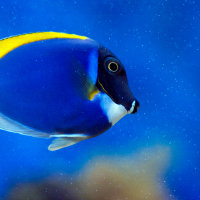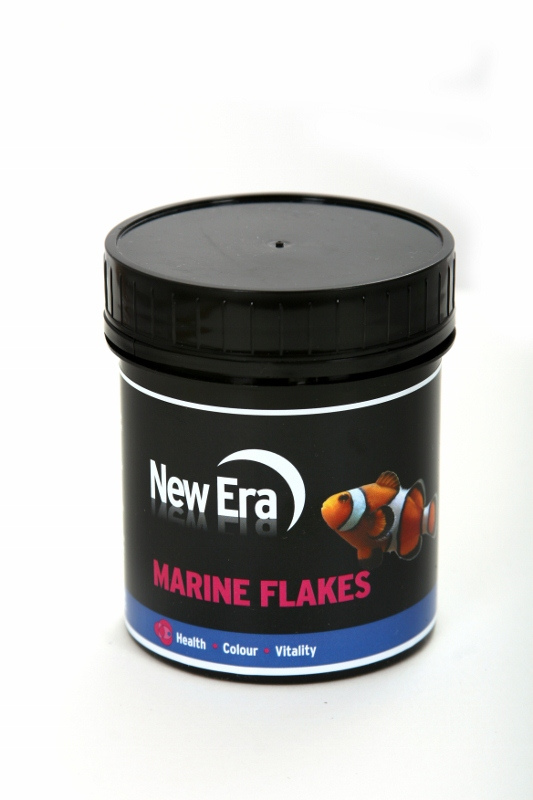
Proper nutrition is one of the most overlooked aspects of the captive care of marine fish. The technology has come a long way in a relatively short time, the days of chucking in a bit of brineshrimp on a daily basis has surely passed. There is a superb variety of different types of food now available from the frozen complete diets through to the many forms of dry, flaked foods and of course various additives to ensure a complete diet.
The old school fishkeepers intuitively fed a varied diet. The trick is to feed as many different sorts of food as is possible. Consider your own feeding habits, how happy would you be if every day you ate the same food?
As much as we think eating our favourite food daily would be great, the reality of this would be somewhat different. Boredom and indeed a hatred of this food would soon set in. The fact isalso that one food cannot supply all our nutritional demands. So why should we expect a bit of brineshrimp should satisfy our fish on a daily basis? In short, it doesn't!
A lot of the fish that we keep in our home tanks are grazers and/or planktonic feeders. In the wild, most of the day would be taken up feeding, yet we feed maybe three times a day at the most! There are many ways of feeding on a more frequent basis, an auto feeder for example, packed with the many different sorts of flake foods available. My particular favourites are the Ocean Nutrition brand (Prime Reef, Formula 1 and 2 etc) and the New Era range of foods (Total Nutrition Marine Flakes, Aegis Flakes, and the new Herbivore Flake) so with a good quality auto feeder (Eheim for example), while at work during the day, we could be feeding our fish four times on good quality flake food, already we have satisfied a vast majority of the nutritional needs of our fish, and were not even back from work yet!

Another bonus of getting our fish onto flake food with an auto feeder is the holiday scenario. Makes life a lot easier, just need somebody to come in maybe once a week (variable on stocking ratios and size of tank) to refill the auto feeder.
The advantages of flake aside, other foods are an important part of our fish?s diet. Again, in the stimulation of the fish?s natural grazing behaviour, consider Reef Gel by Zoolife. This is a powdered food that is mixed with good quality defrosted frozen food (San Francisco Bay Brand, Gamma etc). The food is mixed with the powder until it becomes a putty, gel sort of consistency. This is then stuck onto the rockwork etc to enable the fish to graze on it as they would in the wild. The choice of frozen foods used with this product is important, mix the food up, use different foods etc. Match the frozen food you are feeding to the fish you are keeping and do not just chuck in the brineshrimp! Mysis shrimp has more nutritional benefits, and it meatier and better for your fish. San Francisco Bay Brand chopped mussel is another good choice, especially for slightly larger fish. San Francisco Bay Brand?s Angel and Butterfly Mix is a good choice if you are keeping dwarf or large angels. In short, there are many kinds of frozen foods available, use as many as you can, variety is the key. The only negative comment I get on Reef Gel is the price. Starting at £16.99 it is not a cheap product admittedly. What is worth considering though is that every single piece of frozen food added to the mix, gets to your fish. No more feeding of your clean-up crew (hermit crabs etc) i.e. when you add frozen food normally, the majority of the food ends up all over the tank and never actually feeds your fish! Reef gel stays together if mixed correctly; your fish get it all. With this in mind, does Reef Gel still seem expensive? Or does it balance out against the saving in frozen foods added?
The next food to consider and study is the good old favourite, Nori (seaweed) on a clip. An absolute must if your tank contains herbivorous fish (tangs, rabbit fish and angels to name a few). Again, the use of this food encourages the fish to graze as it would in the wild.
A couple of things need stressing at this point. This method of feeding is not going to guarantee anybody success with hard to feed fish (i.e. seahorses, copperband butterflies, mandarins etc). Seahorses for example have unique feeding requirements dictated by their physical make up. Small stomachs need small regular feedings which can be hard to achieve. This said, the author has had a degree of success getting seahorses onto reef gel making life much easier and more importantly, the seahorses much healthier. With regard to mandarin fish and copperband butterfly fish, as these fish feed off the life contained in the live rock, the most important thing for the successful keeping of these fish is a nice mature tank (1 year plus set up) with the correct amount of good quality live rock.
Also, always remember, we are talking about the little and often method here. Do not add the same amount of food you would add for a once a day feed, six times per day. This would be overfeeding and will be dangerous to all your tank inhabitants' well-being. Little and often is the key.
So to sum up, we have tried to vary the fish's diet, encourage the natural behaviour of the fish (grazing etc) and also encourage the multiple feeding of our fish (5-6 times per day). What does this give us? Basically, happy, hopefully disease-free fish! Of course this way of feeding is not a way of keeping unsuitable fish in an unsuitable aquarium, lets remember, tangs etc get big, some very big, a 2ft cube is really not big enough and no amount of good feeding is going to stop this fish getting stressed and developing stress related disease.
The above feeding plan is a way of keeping fish healthy in a suitable environment.
As a last note, research the fish you are going to buy. Check its feeding requirements and adult size figures. Your marine specialist in your local Maidenhead Aquatics store should be able to help you. A recommended book for this purpose is 'Marine Fishes' by Scott W. Michael available in-store.


